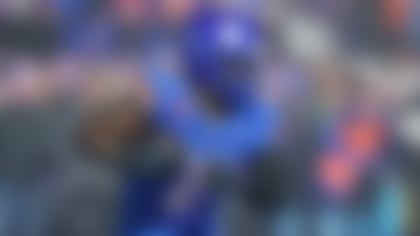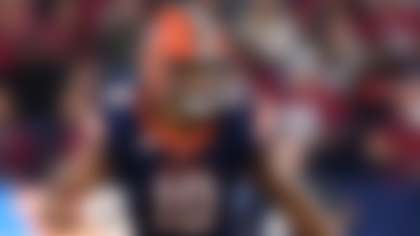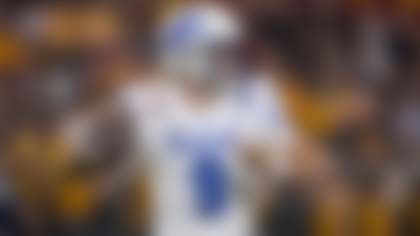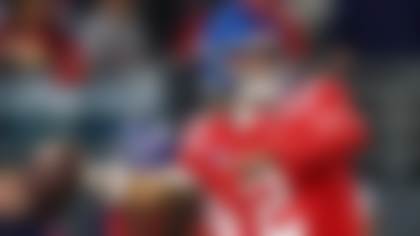With the 2017 NFL Draft is just over five weeks out, NFL Network analyst and former NFL running back Maurice Jones-Drew has his eye on a deep running back class. Based on what he's seen on film and performances from the NFL Scouting Combine and pro days, Jones-Drew ranks this year's RB prospects.
Day 1 starters on any team
1) Joe Mixon, Oklahoma: Some may be surprised that the Oklahoma product is at No. 1, considering his controversial past. The off-the-field incident -- which ultimately kept him from being invited to the NFL Scouting Combine -- is a very serious issue that teams will have to examine extensively before the draft.
What I know about Mixon on the football field is that he's without a doubt the best running back in this year's class. He's versatile, a good route runner, accelerates through contact and has great patience. I recently spoke to a coach who attended Oklahoma's pro day, and he told me Mixon was the best player he had seen in the last 10 years at any pro day. The 6-foot-1, 226-pound running back doesn't have many weaknesses when it comes to football. The only concern -- and it's a significant one -- is his maturity and decision-making outside of football.
2) Dalvin Cook, Florida State: Cook has a leg up on most of these guys, just based on the fact that he's coming out of a pro-style offense. He has great speed (he ran a 4.49-second 40-yard dash at the combine), breaks arm tackles and can score from anywhere on the field. He can be a home-run hitter for any team. However, Cook is a high-risk, high-reward player, as he struggled with turnovers in college, recording 13 fumbles in three years at FSU.
3) Leonard Fournette, LSU: Fournette is an explosive back who accelerates through contact and is dangerous in the open field. He is a solid pass blocker but didn't catch the ball much at LSU with an average of 12.7 catches per season. I'm also concerned about his health. He's been banged up with an ankle injury, and the physicality of the game won't get any easier for him.
4) Christian McCaffrey, Stanford: He has short-area quickness and good contact balance. McCaffrey's ability to catch out of the backfield will make him a threat in the passing game for any team. The Stanford standout touched the ball 300-plus times (including returns) in each of the last two seasons. That's a ton. I'm hoping he wasn't overworked too early.
System players
5) Brian Hill, Wyoming: Hill (6-foot-1, 219 pounds) does a good job getting skinny through holes and, like McCaffrey, has good contact balance. He's an explosive runner with good vision, and he produced on a Wyoming team that was less talented than some of the country's top programs. Hill didn't have a big role in the passing game, hauling in eight receptions for 67 yards in 2016. This part of his game must develop.
6) Jamaal Williams, BYU: Williams has a lot of tools at his disposal. He's a very strong runner, has good vision in a zone scheme and is tough to tackle in the open field. He doesn't catch the ball well, though.
7) Alvin Kamara, Tennessee: Kamara's open-field patience reminds me of LeSean McCoy, as both are great out of the backfield. The Tennessee product has good hands and short-area quickness but doesn't have great speed (running a 4.56 40 at the combine). Because he didn't line up in the I-formation much at Tennessee, he rarely runs through tackles, something he must get comfortable with.
8) Samaje Perine, Oklahoma: Perine is a durable, physical runner and keeps his legs driving on contact. A lot of people like this kid, but my concern is his speed and ability to be a threat in the passing game. He's not a third-down guy and notched a 4.65 40 time at the combine earlier this month.
9) Aaron Jones, UTEP: Jones is my sleeper in this draft. He's versatile, runs good routes and moves well in the open field. He is tough to tackle and has decent speed. Jones is a well-rounded running back -- as he touched the ball on nearly every play at UTEP -- and is good at everything, but not great at one thing.
10) Marlon Mack, South Florida: Mack runs extremely high, which will pose a problem at the next level. He is an Adrian Peterson without power. The South Florida back does, however, have great speed, good vision and can score from anywhere on the field.
11) Tarik Cohen, North Carolina A&T: Cohen is special when the ball is in his hands. He's tough to tackle and great in the open field. He sets up blocks well and has good vision, but the league will be a huge jump in competition for him. Can he continue to be the weapon he was in college against much better competition at the next level?
12) Jeremy McNichols, Boise State: McNichols is a very good football player. He runs good routes, has contact balance and solid hands, but he isn't as dynamic as some others in his class. There's just no "wow" factor here.
13) Kareem Hunt, Toledo: He's got short-area quickness -- making defenders miss in a small area -- and has good hands. I'm impressed with his leg drive on contact (picture Marshawn Lynch-type runs). His speed could be an issue, though, as he ran a 4.62 40 at the combine.
14) D'Onta Foreman, Texas: Foreman has good speed for a 6-foot, 233-pound back. He breaks a lot of tackles with his explosive, downhill running style. He played in a spread system at Texas and was involved very little in the passing game. That's something he'll need to become more comfortable with going forward, and it'll take some time to learn how to play in a pro-style offense.
15) Donnel Pumphrey, San Diego State: Pumphrey is fast, quick and patient when the ball is in his hands. His 5-8, 176-pound frame is a concern, because I just don't know if he can last at the next level. And getting bigger will take away from what he does best.
16) James Conner, Pittsburgh: What a feel-good story. Like Eric Berry, Conner had Hodgkin lymphoma and is a cancer survivor. Now healthy, Connor looks to be an impact player in the NFL. He is a big back who is very physical, explosive with his shoulders and finishes runs. He is a true downhill runner as a first- and second-down back. Can Conner be a threat out of the backfield? He didn't line up outside, so there are question marks about his ability to impact the passing game.
Need time to develop
17) Wayne Gallman, Clemson: Gallman catches the ball well out of the backfield but gets lost at times in pass protection. As a shifty back, he's a tough open-field runner. I'd like to see him run with a lower pad level and accelerate through contact.
18) De'Angelo Henderson, Coastal Carolina: Some people say Henderson reminds them of me when I played, but I still need to be convinced. The Coastal Carolina RB is a strong runner and has a good jump cut. Not to mention, the guy knows how to score. He got in the end zone in 35 straight games in college. The competition level will be a huge jump for Henderson, and he'll need to learn how to read out of the I-formation.
19) T.J. Logan, North Carolina: Logan excels in the open field and has great speed as a return specialist. He must be more physical and improve on lowering his pad level when running the ball if he wants to be more involved in the ground game at the next level.
20) Christopher Carson, Oklahoma State: Carson has good size at 6-feet, 218 pounds, explodes through holes at the line of scrimmage and has a nose for the end zone. He's patient in the run game and has decent hands in the pass game. But I think Carson needs to show more want in pass protection by being more physical. He carries the ball in his right hand only. That will need to change.
21) Matt Dayes, North Carolina State: The N.C. State product is hard to tackle in the open field and has good hands. Although being a shifty runner can play as a strength, he needs to learn to run with a low pad level. He comes through holes too high at times.
22) Corey Clement, Wisconsin: This downhill runner is a first- and second-down back. Clement has nice feet -- getting them in and out of bad positions -- for his size (5-10, 220 pounds). He does a good job at breaking tackles but needs to work on pass routes, which is why he likely won't be used on third and fourth down. His speed could also use a boost after he ran a 4.68 40 in Indy.
23) Elijah Hood, North Carolina: A strong and physical player, Hood finishes runs and will be a solid first- and second-down guy in the NFL. He's got good vision and runs with a low pad level. The knock against this kid is he doesn't catch the ball out of the backfield.
24) Elijah McGuire, Louisiana-Lafayette: McGuire is a quick, physical runner who accelerates through contact. He has the potential to be involved in the passing game with good hands. Like many of these guys, it'll take him time to learn a pro-style offense after playing in a spread system in college.
25) Justin Davis, USC: Davis has an Arian Foster-like running style as a one-cut runner. Davis has good vision and good hands, but I want to see him run with more power and use a stiff-arm or shake defenders off. He lets too many players get to his body.
26) Devine Redding, Indiana: Redding is a one-cut runner with good vision and acceleration through the hole. He's another prospect who will have to learn a pro-style offense. He's likely going to be a player who will get first downs, not touchdowns.
27) De'Veon Smith, Michigan: He is a strong runner, but he isn't very elusive and doesn't make people miss. Smith needs to develop open-field moves to shake off defenders.
28) Rushel Shell, West Virginia: Shell is comparable to Smith. He's a good north-south runner, and developing open-field moves will make him more versatile. Shell must improve his catching ability and speed.
29) Jahad Thomas, Temple: Thomas is quick and shifty and can improve his game by becoming an inside runner. He must lower his pad level and burst through the hole.
30) Dare Ogunbowale, Wisconsin: This Wisconsin RB runs with great lean and has good feet and short-area quickness. As a third-down back, Ogunbowale, who ran a slow 4.65 40, will move the chains but isn't going to be the guy getting in the end zone.
31) Stanley Williams, Kentucky: Williams has decent vision, good hands and short-area quickness. The Kentucky product doesn't run through contact consistently and will have to learn how to be effective in a pro-style offense.
32) Joe Williams, Utah: Williams is very fast with good feet, but there's not much else to his skill set. He had a monster game against UCLA last season, recording over 300 rushing yards, and every run was a sprint. Becoming more elusive will improve his stock.
33) Tyvis Smith, Northern Iowa: Smith is a physical runner who keeps his feet driving on contact. He is a downhill runner with decisive burst but needs to improve on speed and open-field moves. I also question the competition he faced while at Northern Iowa. (However, fellow former Panther David Johnson had no problem adjusting.)
34) Tarean Folston, Notre Dame: Folston is a tough runner and has good quickness and vision. He suffered a season-ending knee injury in 2015 and looked somewhat hesitant in his first year of recovery. Hopefully, his injury won't hold him back.
Follow Maurice Jones-Drew on Twitter _@JonesDrew32_.












